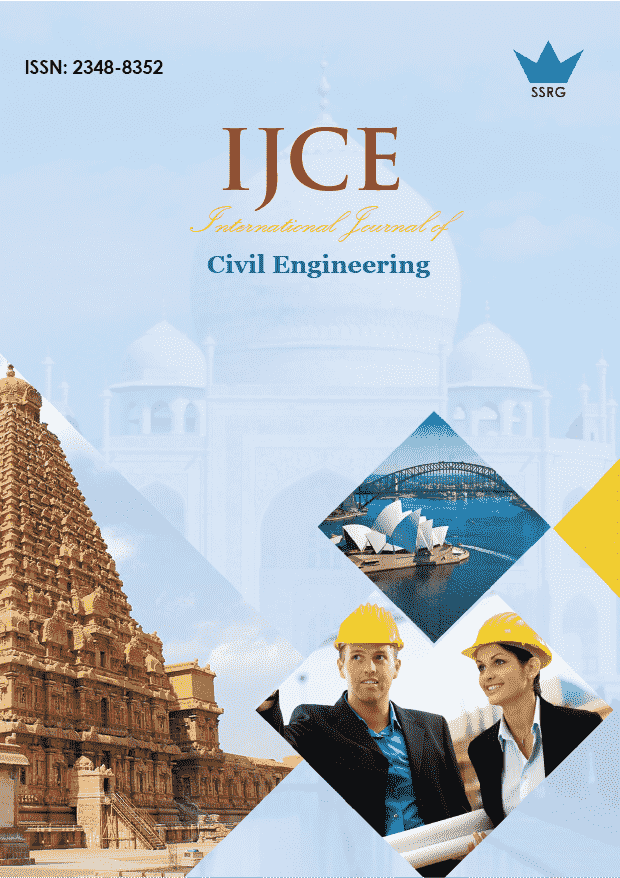Comparative Evaluation of Groundwater Parameters Simulation by Method of Linear & Quadratic Shape Function

| International Journal of Civil Engineering |
| © 2017 by SSRG - IJCE Journal |
| Volume 4 Issue 10 |
| Year of Publication : 2017 |
| Authors : C. Ukpaka, F. E. Ezeilo |
How to Cite?
C. Ukpaka, F. E. Ezeilo, "Comparative Evaluation of Groundwater Parameters Simulation by Method of Linear & Quadratic Shape Function," SSRG International Journal of Civil Engineering, vol. 4, no. 10, pp. 1-26, 2017. Crossref, https://doi.org/10.14445/23488352/IJCE-V4I10P103
Abstract:
The investigation presented in this article is aimed at evaluating the selected physico-chemical parameters of ground water and the best approach of simulating the selected water quality parameters migration in Sama community water bearing aquifer, comparison were made between linear and quadratic shape function. Approximation of Finite Element Established by Galerkins’s, the linear shape function approximation of finite element approach gives a decrease in the selected physico-chemical parameters as parameters dispersed from a given point to another during the simulation of the One -Dimensional mass transport equation of the groundwater and the result follows an acceptable sequential order as demonstrated in this article while quadratic shape function approximation of finite element results were rising and falling along the considered distances and nodes of interest which do not shows a sound sequential dispersion along the investigated distances.
Keywords:
Simulation, finite element, linear shape function Quadratic shape function.
References:
1) AGUNNWABA, J.C (2001): Waste engineering and management tools, 1st edition, immaculate publication ltd, No.2 aku street, Ogui N/layout, Enugu, P.366 – 371.
2) APHA (1981): Standard methods for examination of water & waste water (15ed) America public Health Association, AWWA, WPCF, WASHINGTON DC.
3) CARROL .D. (1962): Rain water as a chemical agent of geological progress – A review, geological survey, water – spply, 1535-6.
4) CHATTERJEE, A.K (2010): Water supply, waste disposal and environmental engineering. Romeshchanderkhanna for khanna publisher, 2-B, Nath market, Naisarak, Delhi – 110006. P.1 -201.
5) DASH. J. R., DASH. P. C. AND PATRA. H. K., (2006), A correlation and regression study on the ground water quality in rural areas around Angul – Talcher industrial zone, international journal of environmental protection, 26(6), pp. 550 – 558.
6) ELUOZO,S.N. AND NWOFOR, T.C.(2012), Evaluating the variation of transmissivity on groundwater development in Rivers State. International Journal of Applied Environmental Science, 7(2), 141-147.
7) EPA (1990) environmental pollution control alternatives: Drinking water treatment for small communities .EPA /625/5-90/025.
8) GAJENDRAN C., THAMARAI P., AND BASKAR., (2010), Water quality evaluation for Nambiyar river basin, Tamil, India by using geo – statistical analysis, Asian Journal of Microbiology, Biotechnology and environmental science, 12(3), pp. 555 – 560.
9) GARG, S.K.(2007), Hydrology and Water Resources Engineering, 14th Revised Edition, Romesh Chander Khanna for Khanna publishers 2-B, Nath Market, Nai Sarak, Delhi- 110006. pp.700-703.
10) GERARD, K.(1998): Environmental engineering, international edition Mcgraw-Hill, New York, P.200-22g.
11) GOEL, P.K (2006): Water pollution, causes, effects and control. New Age internation (P) Ltd, publishers, P.1 – 300.
12) KOLENBRANDER, G.J. (1975): Nitrogen in organic matter and fertilizer as a source of pollution in processing of LAWPR conference “Nitrogen as a water pollutant” compenhagen.
13) LETON, T. (2007): Water and waste engineering, pearl publishers, Port Harcourt, Nigeria, P23-38.
14) NWAOGAZIE I.L (2008): Finite element modeling of engineering system with emphasis is water resources, 2nd Edition, University of Port Harcourt press, Nigeria, P45 – 177.
15) OGEDENGBE A. O., ABBA M. U., (2006), An assessment of Dug – well water quality and uses in Mubi, Nigeria, Journal of Sustainable Development in Agriculture and Development, 2(1), p. 10.
16) OKEKE C. O. IGBOANUA A. H. (2003), Characteristics and quality assessment of surface water and ground water resources of Akwa Town, Southeast, Nigeria. J. Niger. Assoc. Hydrol. Geol., 14, p. 71 – 77.
17) PATHAK H., LIMAYE S. N. (2011D), A mathematical modeling with respect to DO for environmentally contaminated drinking water sources of Makronia sub-urban area, India: A case study, Ovidius University Annals of Chemistry, Vol. 22(2), 2011. ISSN – 1223 – 7221.
18) PATHAK H., LIMAYE S. N. (2012A), Assessment of Physico – chemical quality of municipal water samples of Makronia sub – urban RArea of Bundel Khand Region, India, Anaele University din Oradea – Seria Geografie, 2, 122 – 127.
19) PATHAK, H., LIRMAYE, S. N. (2012B). A water quality index mathematical modeling of water samples of Rajghat, water supply reservoir sagar (M. P.) with respect to total dissolved solids: A regression analysis, the polytechnic institute of Iasi, 2012, vol. 1, ISSN: 0254 – 70104.
20) PATOWARY, KABITA AND BHATTACHARYA K. G., (2005), Evaluation of drinking water quality of coalmining area, Assam, Indian Journal environmental protection, 25(3), pp. 204 – 211.
21) SINCERO, A.P and SINCERO A.G (1999): Environmental engineering, prentence – hall of India pride limited New Delhi ~ 11 0001 P.1~85.
22) SULEIMAN F. B. (2006), Analysis of some sachet water samples in Katsina, Nigeria, Chem. Class journal of Chemical Society of Nigeria, Zaria chapter, 3, p. 42 – 44.
23) UKPAKA C. P. AND UKPAKA C. (2016), Characteristics of Groundwater in Port – Harcourt. Journal of Advances in Environmental sciences. Volume 1 Number 2, pp 59 – 71.
24) UKPAKA, C., IFY, L.N., PETER, U.C., (2015). Prediction of nitrate interaction for Egi Clan groundwater investigation in Rivers State of Nigeria. CASRP Journal of Applied Sciences, 1(14), 118-132.
25) WHO (1984): Guidelines for drinking water quality vol.2. Health criteria and other supporting information ch.16. Geneva. PP145-150.

 10.14445/23488352/IJCE-V4I10P103
10.14445/23488352/IJCE-V4I10P103